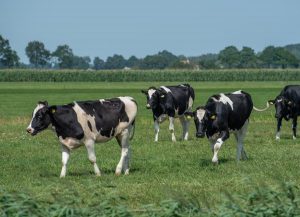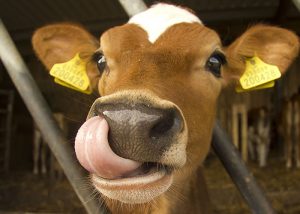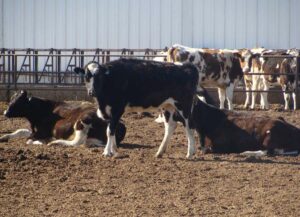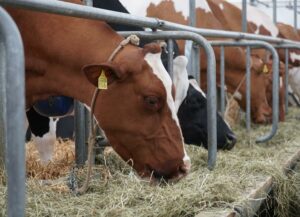Alvaro Garcia
Feeding calves milk replacer is the best economic solution for dairy farmers when there is a shortage of non-saleable milk. Feeding good quality milk replacer (MR) offers other advantages such as consistency, as well as protection from disease transmission. Of recent interest has been to determine the right amount to be fed to ensure health and rapid growth.
Research has shown that changes in nutrient uptake can modify gene expression resulting in changes in performance. One concern that has been reported is that the advantages of feeding calves’ large quantities of milk or MR (which results in greater body weight at weaning) are usually lost by 4 months of age compared with more moderate MR feeding regimens. It is suspected this happens as a result of reduced rumen development when larger amounts of MR or milk are fed.
Research has reported for example that although calves fed 8 L/day of MR (25% protein, 19% fat with 12.5% solids) weighed 3.7 kg more at weaning than those fed 6 L/day of MR, their BW at weaning (day 73) and on day 228 were similar between both feeding regimens. These results however have not been consistent, with some reporting reduced average daily gain (ADG), whereas others showed no short-term effects.
Most studies, however, have shown a reduction in structural growth postweaning, which is suspected to be the result of reduced solid feed digestion. The importance of an optimal transition during weaning to a completely solid diet has also been underscored.
In one experiment calves fed a high-MR diet and weaned gradually (step-down over 3 weeks) increased postweaning digestion and growth in comparison to calves fed high levels of MR and weaned over a just one-week step-down approach. It seems that allowing more time for transition allows for better rumen development, a more efficient solid feed digestion, with resultant increased performance post weaning.
To test this hypothesis Klopp et al. (2020) evaluated the carryover effects of MR feeding rate and weaning strategy on growth and nutrient digestibility of weaned dairy calves up to 4 months of age.
Holstein calves, 2 to 3 days of age were housed in individual hutches and fed 3 L of fresh colostrum within 1 hour of birth, another 3 L 12 hours later, and then followed by 2 L of pasteurized milk twice daily.
Calves were then fed 0.66 kg of dry matter (DM) from MR (24.9% protein, 17.8% fat) the first p.m. and the next a.m., then assigned to 1 of 4 treatments in a 2 x 2 factorial experimental design as follows:
- Moderate MR/abrupt (1 step-down) weaning (MOD-AB; 0.66 kg for the first 42 days, and 0.33 kg for the last 7 days, a.m. only)
- Moderate MR/gradual (2 step-down) weaning (MOD-GR; 0.66 kg for 28 days, then 0.33 kg for 14 days, a.m. only; then 0.17 kg for 7 days, a.m. only)
- High MR/abrupt weaning (HI-AB; 0.66 kg for 7 days, 0.82 kg for 7 days, 1.1 kg for 28 days, then 0.66 kg for the last 7 days, a.m. only)
- High MR/gradual weaning (HI-GR; 0.66 kg for 7 days, 0.82 kg for 7 days, 1.1 kg for 14 days, 0.66 kg for 14 days, a.m. only, then 0.33 kg for the last 7 days, a.m. only).
Calves fed more milk replacer experienced less growth postweaning
Gradual weaning was effective when used to transition calves on a high milk replacer regimen. The increased growth parameters seen before weaning lasted through day 35 (~91 days of age), but the performance of all treatments converged by day 56 of the study (~112 d of age). No differences were detected for ADG, final BW, final hip height, final hip width, or final BCS based on milk replacer amount or weaning strategy by day 56 (~112 days of age).
It was confirmed that calves fed more MR experienced less growth postweaning than calves fed moderate MR, however the moderate-MR calves reduced the growth gap by day 56 postweaning. There were no differences in digestibility coefficients at day 56 (~112 days of age) between treatments, except for starch.
The authors concluded that calves on a program of moderate MR did not benefit by extending the weaning period to 3 weeks, as in gradual weaning, compared with 1 week as in a single-step weaning. However, when calves are administered high amounts of MR, the regimen should be paired with a gradual weaning process for better growth and development.
Reference
R. N. Klopp, F. X. Suarez-Mena, T. S. Dennis, T. M. Hill, R. L. Schlotterbeck, and G. J. Lascano. 2020. Postweaning response on growth and nutrient digestion to using different weaning strategies when feeding moderate and high amounts of milk replacer to Holstein calves. J. Dairy Sci. 103:8143–8150.
© 2020 Dairy Knowledge Center. All Rights Reserved.









